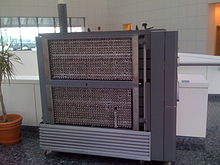- IBM 701
-
The IBM 701, known as the Defense Calculator while in development, was announced to the public on April 29, 1952, and was IBM’s first commercial scientific computer.[1] Its business computer siblings were the IBM 702 and IBM 650.
Contents
Description
The system used electrostatic storage, consisting of 72 Williams tubes with a capacity of 1024 bits each, giving a total memory of 2048 words of 36 bits each. Each of the 72 Williams tubes was three inches in diameter. Memory could be expanded to a maximum of 4096 words of 36 bits by the addition of a second set of 72 Williams tubes or by replacing the entire memory with magnetic core memory. The Williams tube memory and later core memory each had a memory cycle time of 12 microseconds. The Williams tube memory required periodic refreshing, mandating the insertion of refresh cycles into the 701s timing. An addition required five 12 microsecond cycles, two of which were refresh cycles, a multiplication or division required 38 cycles (456 microseconds).
Instructions were 18 bits long, single address.
- Sign (1 bit) - Whole word (-) or Half word (+) operand address
- Opcode (5 bits) - 32 instructions
- Address (12 bits) - 4096 Half word addresses
Numbers were either 36 bits or 18 bits long, signed magnitude, fixed point.
The IBM 701 had only 2 programmer accessible registers:
- The accumulator was 38 bits long (adding 2 overflow bits).
- The multiplier/quotient was 36 bits long.
The IBM 701 system was composed of the following units:
- IBM 701 - Analytical Control Unit (CPU)
- IBM 706 - Electrostatic Storage Unit (2048 words of CRT Memory)
- IBM 711 - Punched Card Reader (150 Cards/min.)
- IBM 716 - Printer (150 Lines/min.)
- IBM 721 - Punched Card Recorder (100 Cards/min.)
- IBM 726 - Magnetic Tape Reader/Recorder (100 Bits/inch)
- IBM 727 - Magnetic Tape Reader/Recorder (200 Bits/inch)
- IBM 731 - Magnetic Drum Reader/Recorder
- IBM 736 - Power Frame #1
- IBM 737 - Magnetic Core Storage Unit (4096 words of Core Memory)
- IBM 740 - Cathode Ray Tube Output Recorder
- IBM 741 - Power Frame #2
- IBM 746 - Power Distribution Unit
- IBM 753 - Magnetic Tape Control Unit (controlled up to ten IBM 727s)
Nineteen IBM 701 systems were installed.[2] The University of California at Livermore developed a language compilation and runtime system called the KOMPILER for their 701. A Fortran compiler was not released by IBM until the IBM 704.
The 701 can claim to be the first computer displaying the potential of artificial intelligence in Arthur Samuel's Checkers-playing Program.[3]
IBM 701 competed with Remington Rand's ERA 1103 in the scientific computation market, which had been developed for the NSA, so held secret until permission to market it was obtained in 1953. In early 1954, a committee of the Joint Chiefs of Staff requested that the two machines be compared for the purpose of using them for a Joint Numerical Weather Prediction project. Based on the trials, the two machines had comparable computational speed, with a slight advantage for IBM's machine, but the latter was favored unanimously for its significantly faster input-output equipment.[4]
The successor of the 701 was the index register-equipped IBM 704, introduced 4 years after the 701. The 704 was not compatible with the 701, however, as the 704 increased the size of instructions from 18 bits to 36 bits to support the extra features. The 704 also marked the transition to magnetic core memory.
A market for only five computers
"I think there is a world market for maybe five computers" is often attributed to Thomas Watson; Senior in 1943 and Junior at several dates in the 1950s. This misquote is from the 1953 IBM annual stockholders meeting. Thomas Watson, Jr. was describing the market acceptance of the IBM 701 computer. Before production began, Watson visited with 20 companies that were potential customers. This is what he said at the stockholders meeting, "as a result of our trip, on which we expected to get orders for five machines, we came home with orders for 18.”[5]
See also
- List of IBM products
- SHARE (computing)
- Strela computer, comparable Soviet design
References
- ^ "IBM Archives: IBM 701 Electronic analytical control unit". http://www-03.ibm.com/ibm/history/exhibits/701/701_1415bx01.html.
- ^ "IBM Archives: 701 Customers". http://www-1.ibm.com/ibm/history/exhibits/701/701_customers.html.
- ^ "Memorial Resolution: Arthur L. Samuel". Stanford University Historical Society. 1990. http://histsoc.stanford.edu/pdfmem/SamuelA.pdf. Retrieved April 29, 2011.
- ^ Emerson W. Pugh, Lyle R. Johnson, John H. Palmer, IBM's 360 and early 370 systems, MIT Press, 1991, ISBN 0262161230 pp. 23-34
- ^ "Frequently Asked Questions". IBM. April 10, 2007. p. 26. http://www-03.ibm.com/ibm/history/documents/pdf/faq.pdf.
- Charles J. Bashe, Lyle R. Johnson, John H. Palmer, Emerson W. Pugh, IBM's Early Computers (MIT Press, Cambridge, 1986)
- Cuthbert Hurd (editor), Special Issue: The IBM 701 Thirtieth Anniversary - IBM Enters the Computing Field, Annals of the History of Computing, Vol. 5 (No. 2), 1983
External links
- Oral history interview with Gene Amdahl Charles Babbage Institute, University of Minnesota, Minneapolis. Amdahl discusses his role in the design of several computers for IBM including the STRETCH, IBM 701, and IBM 704. He discusses his work with Nathaniel Rochester and IBM's management of the design process for computers.
- A Notable First: The IBM 701
- The Williams Tube
- IBM 701 documents on Bitsavers.org
Categories:- IBM vacuum tube computers
- IBM 700/7000 series
- 1952 introductions
Wikimedia Foundation. 2010.


